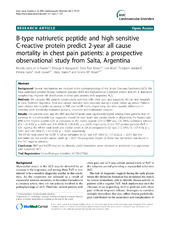| dc.contributor.author | Fuente, Ricardo León de la | en_US |
| dc.contributor.author | Næsgaard, Patrycja A. | en_US |
| dc.contributor.author | Nilsen, Stein Tore | en_US |
| dc.contributor.author | Woie, Leik | en_US |
| dc.contributor.author | Aarsland, Torbjørn | en_US |
| dc.contributor.author | Gallo, Patricio | en_US |
| dc.contributor.author | Grundt, Heidi | en_US |
| dc.contributor.author | Staines, Harry | en_US |
| dc.contributor.author | Nilsen, Dennis W. T. | en_US |
| dc.date.accessioned | 2012-01-23T10:30:12Z | |
| dc.date.available | 2012-01-23T10:30:12Z | |
| dc.date.issued | 2011-09-29 | eng |
| dc.Published | BMC Cardiovascular Disorders 2011, 11:57 | en |
| dc.identifier.issn | 1471-2261 | |
| dc.identifier.uri | https://hdl.handle.net/1956/5491 | |
| dc.description.abstract | Background: Several mechanisms are involved in the pathophysiology of the Acute Coronary Syndrome (ACS). We have addressed whether B-type natriuretic peptide (BNP) and high-sensitive C-reactive protein (hsCRP) in admission samples may improve risk stratification in chest pain patients with suspected ACS. Methods: We included 982 patients consecutively admitted with chest pain and suspected ACS at nine hospitals in Salta, Northern Argentina. Total and cardiac mortality were recorded during a 2-year follow up period. Patients were divided into quartiles according to BNP and hsCRP levels, respectively, and inter quartile differences in mortality were statistically evaluated applying univariate and multivariate analyses. Results: 119 patients died, and the BNP and hsCRP levels were significantly higher among these patients than in survivors. In a multivariable Cox regression model for total death and cardiac death in all patients, the hazard ratio (HR) in the highest quartile (Q4) as compared to the lowest quartile (Q1) of BNP was 2.32 (95% confidence interval (CI), 1.24-4.35), p = 0.009 and 3.34 (95% CI, 1.26-8.85), p = 0.015, respectively. In the TnT positive patients (TnT > 0.01 ng/mL), the HR for total death and cardiac death in Q4 as compared to Q1 was 2.12 (95% CI, 1.07-4.18), p = 0.031 and 3.42 (95% CI, 1.13-10.32), p = 0.029, respectively. The HR for total death for hsCRP in Q4 as compared to Q1 was 1.97 (95% CI, 1.17-3.32), p = 0.011, but this biomarker did not predict cardiac death (p = 0.21). No prognostic impact of these two biomarkers was found in the TnT negative patients. Conclusion: BNP and hsCRP may act as clinically useful biomarkers when obtained at admission in a population with suspected ACS. | en_US |
| dc.language.iso | eng | eng |
| dc.publisher | BioMed Central | eng |
| dc.relation.ispartof | <a href="http://hdl.handle.net/1956/6726" target="blank">Prognostic indicators of total-, cardiac- and sudden cardiac death in chest pain patients with suspected acute coronary syndrome (ACS).</a> | eng |
| dc.rights | Attribution CC BY | eng |
| dc.rights.uri | http://creativecommons.org/licenses/by/2.0/ | eng |
| dc.title | B-type natriuretic peptide and high sensitive C-reactive protein predict 2-year all cause mortality in chest pain patients: a prospective observational study from Salta, Argentina | en_US |
| dc.type | Peer reviewed | |
| dc.type | Journal article | |
| dc.description.version | publishedVersion | en_US |
| dc.rights.holder | Copyright 2011 de la Fuente et al; licensee BioMed Central Ltd. | |
| dc.identifier.doi | https://doi.org/10.1186/1471-2261-11-57 | |
| dc.identifier.cristin | 868517 | |
| dc.subject.nsi | VDP::Medical disciplines: 700::Clinical medical disciplines: 750::Cardiology: 771 | eng |

